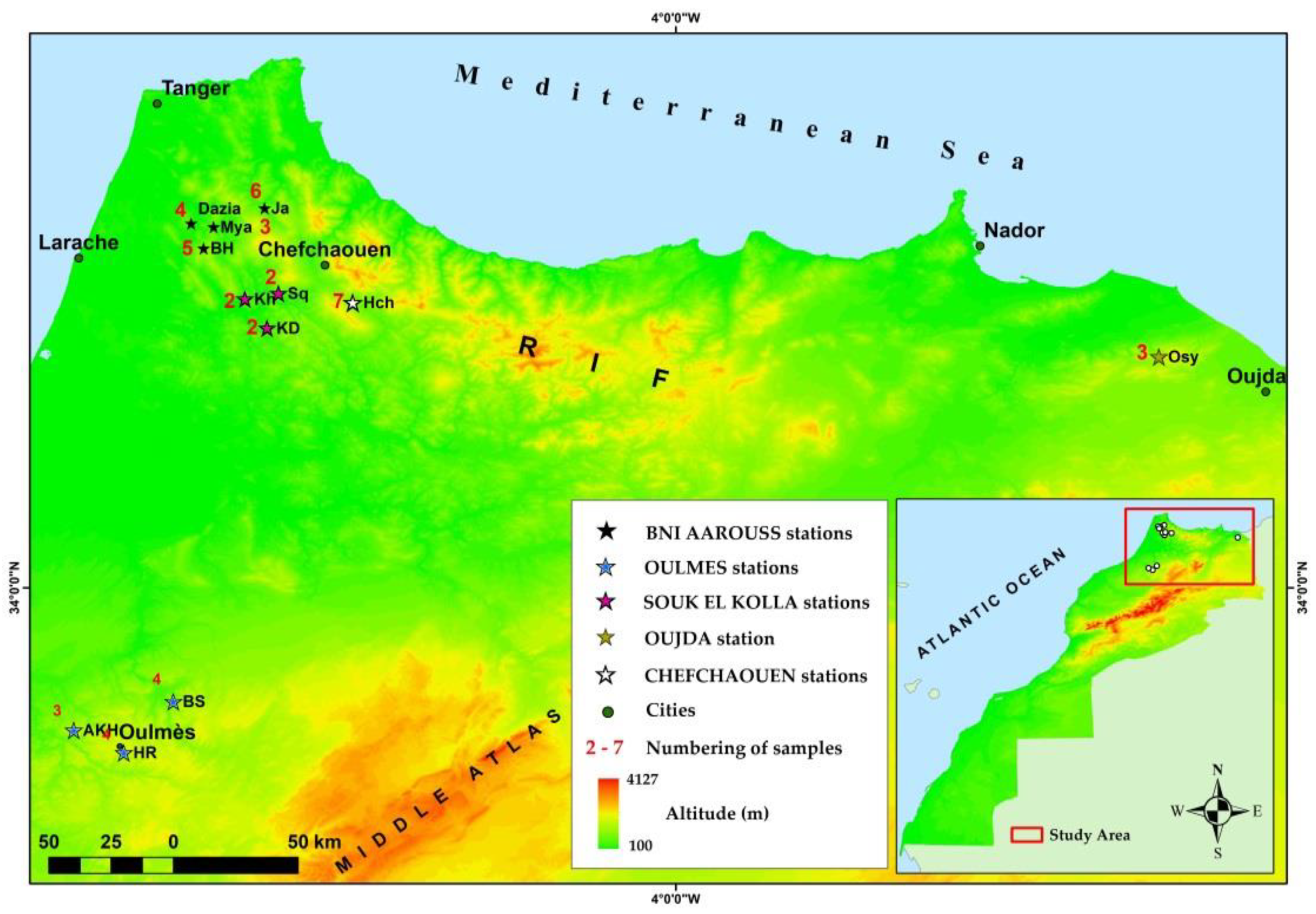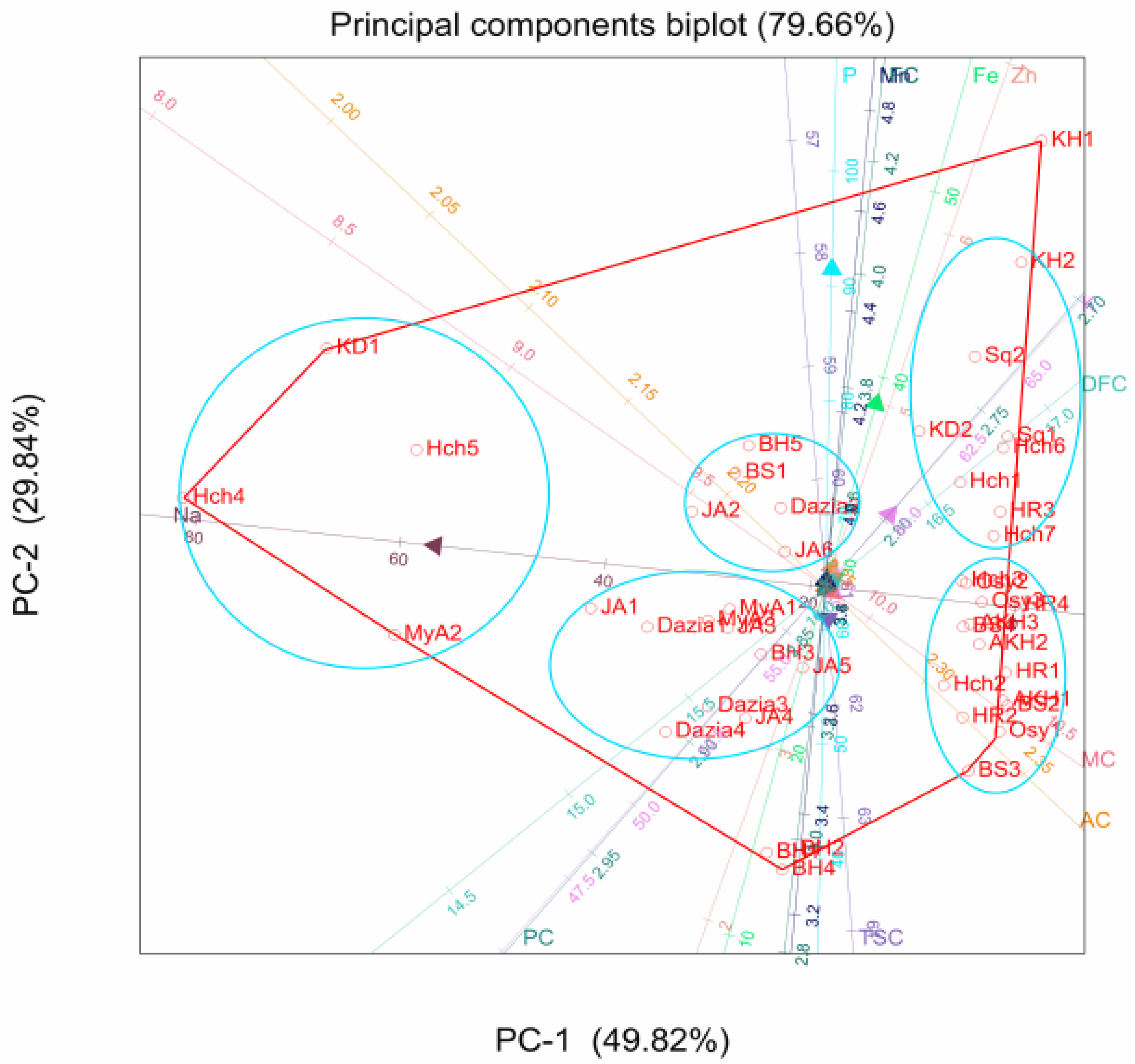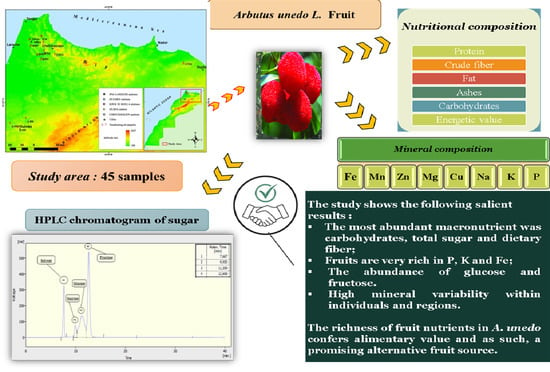Moroccan Strawberry Tree (Arbutus unedo L.) Fruits: Nutritional Value and Mineral Composition
Abstract
:1. Introduction
2. Materials and Methods
2.1. Plant Material and Experimental Areas
2.2. Analytical Methods
2.2.1. Nutrients Composition
2.2.2. Soluble Sugars
2.2.3. Mineral Composition
2.2.4. Statistical Analysis
3. Results
3.1. Nutritional Composition
3.2. Nutritional Value Variability
3.3. Geographical Repartition of Mineral Composition
3.4. Soluble Sugars Profile
4. Discussion
5. Conclusions
Author Contributions
Funding
Data Availability Statement
Acknowledgments
Conflicts of Interest
References
- Rivera, D.; Obon, C.; Heinrich, M.; Inocencio, C.; Verde, A.; Fajardo, J. Gathered Mediterranean food plants–ethnobotanical investigations and historical development. Forum Nutr. 2006, 59, 18–74. [Google Scholar] [CrossRef]
- Soufleros, E.; Mygdalia, S.; Natskoulis, P. Production process and characterization of the traditional Greek fruit distillate “Koumaro” by aromatic and mineral composition. J. Food Compos. Anal. 2005, 18, 699–716. [Google Scholar] [CrossRef]
- Tardío, J.; Pardo-de-Santayana, M.; Morales, R. Ethnobotanical review of wild edible plants in Spain. Bot. J. Linn. Soc. 2006, 152, 27–71. [Google Scholar] [CrossRef]
- Nunes, R.J.D.S. Micromedronho: Design of Microencapsulated Arbutus Unedo Leaves and Fruits by Spray Drying for Supplements and Functional Foods; Universidade do Algarve: Faro, Portugal, 2017. [Google Scholar]
- Kachkoul, R.; Housseini, T.S.; Mohim, M.; El Habbani, R.; Miyah, Y.; Lahrichi, A. Chemical compounds as well as antioxidant and litholytic activities of Arbutus unedo L. leaves against calcium oxalate stones. J. Integr. Med. 2019, 17, 430–437. [Google Scholar] [CrossRef]
- Trichopoulou, A.; Vasilopoulou, E.; Hollman, P.; Chamalides, C.; Foufa, E.; Kaloudis, T.; Kromhout, D.; Miskaki, P.; Petrochilou, I.; Poulima, E. Nutritional composition and flavonoid content of edible wild greens and green pies: A potential rich source of antioxidant nutrients in the Mediterranean diet. Food Chem. 2000, 70, 319–323. [Google Scholar] [CrossRef]
- Barros, L.; Venturini, B.A.; Baptista, P.; Estevinho, L.M.; Ferreira, I.C. Chemical composition and biological properties of portuguese wild mushrooms: A comprehensive study. J. Agric. Food. Chem. 2008, 56, 3856–3862. [Google Scholar] [CrossRef] [PubMed]
- Alarcão-E-Silva, M.; Leitão, A.; Azinheira, H.; Leitão, M. The Arbutus Berry: Studies on its color and chemical characteristics at two mature stages. J. Food Compos. Anal. 2001, 14, 27–35. [Google Scholar] [CrossRef]
- Oliveira, I.; Baptista, P.; Malheiro, R.; Casal, S.; Bento, A.; Pereira, J.A. Influence of strawberry tree (Arbutus unedo L.) fruit ripening stage on chemical composition and antioxidant activity. Food Res. Int. 2011, 44, 1401–1407. [Google Scholar] [CrossRef]
- Ruiz-Rodríguez, B.-M.; Morales, P.; Fernández-Ruiz, V.; Sánchez-Mata, M.-C.; Camara, M.; Díez-Marqués, C.; Pardo-de-Santayana, M.; Molina, M.; Tardío, J. Valorization of wild strawberry-tree fruits (Arbutus unedo L.) through nutritional assessment and natural production data. Food Res. Int. 2011, 44, 1244–1253. [Google Scholar] [CrossRef]
- Salem, I.B.; Ouesleti, S.; Mabrouk, Y.; Landolsi, A.; Saidi, M.; Boulilla, A. Exploring the nutraceutical potential and biological activities of Arbutus unedo L.(Ericaceae) fruits. Ind. Crops Prod. 2018, 122, 726–731. [Google Scholar] [CrossRef]
- Tenuta, M.C.; Tundis, R.; Xiao, J.; Loizzo, M.R.; Dugay, A.; Deguin, B. Arbutus species (Ericaceae) as source of valuable bioactive products. Crit. Rev. Food Sci. Nutr. 2019, 59, 864–881. [Google Scholar] [CrossRef]
- Celikel, G.; Demirsoy, L.; Demirsoy, H. The strawberry tree (Arbutus unedo L.) selection in Turkey. Sci. Hortic. 2008, 118, 115–119. [Google Scholar] [CrossRef]
- Akkol, E.K.; Yesilada, E.; Guvenc, A. Valuation of anti-inflammatory and antinociceptive activities of Erica species native to Turkey. J Ethnopharmacol. 2008, 116, 251–257. [Google Scholar] [CrossRef] [PubMed]
- Heinrich, M.; Nebel, S.; Leonti, M.; Rivera, D.; Obón, C. ‘Local Food-Nutraceuticals’: Bridging the gap between local knowledge and global needs. Forum Nutr. 2006, 59, 1–17. [Google Scholar] [CrossRef] [PubMed]
- Özcan, M.M.; Hacıseferoğulları, H. The strawberry (Arbutus unedo L.) fruits: Chemical composition, physical properties and mineral contents. J. Food Eng. 2007, 78, 1022–1028. [Google Scholar] [CrossRef]
- Pallauf, K.; Rivas-Gonzalo, J.C.; Del Castillo, M.; Cano, M.P.; de Pascual-Teresa, S. Characterization of the antioxidant composition of strawberry tree (Arbutus unedo L.) fruits. J. Food Compos. Anal. 2008, 21, 273–281. [Google Scholar] [CrossRef] [Green Version]
- Delgado-Pelayo, R.; Gallardo-Guerrero, L.; Hornero-Mendez, D. Carotenoid composition of strawberry tree (Arbutus unedo L.) fruits. Food Chem. 2016, 199, 165–175. [Google Scholar] [CrossRef] [Green Version]
- Mrabti, H.N.; Marmouzi, I.; Sayah, K.; Chemlal, L.; El Ouadi, Y.; Elmsellem, H.; Cherrah, Y.; Faouzi, M.A. Arbutus unedo L aqueous extract is associated with in vitro and in vivo antioxidant activity. J. Mater. Environ. Sci. 2017, 8, 217–224. [Google Scholar]
- AOAC. Official methods of analysis. Assoc. Anal. Chem. 1990, 73(4), 485–486. [Google Scholar]
- Association of Official Analytical Chemists; Horwitz, W. Official Methods of Analysis; Association of Official Analytical Chemists: Washington, DC, USA, 1975; Volume 222. [Google Scholar]
- Williams, S. Official Methods of Analysis, 14th ed.; Association of Official Analytical Chemists: Arlington, VI, USA, 1984. [Google Scholar]
- Dubois, M.; Gilles, K.A.; Hamilton, J.K.; Rebers, P.T.; Smith, F. Colorimetric method for determination of sugars and related substances. Anal. Chem. 1956, 28, 350–356. [Google Scholar] [CrossRef]
- Lupton, J.R.; Brooks, J.; Butte, N.; Caballero, B.; Flatt, J.; Fried, S. Dietary Reference I intakes for Energy, Carbohydrate, Fiber, Fat, Fatty Acids, Cholesterol, Protein, and Amino Acids; National Academy Press: Washington, DC, USA, 2002; Volume 5, pp. 589–768. [Google Scholar]
- Kim, T.H.; Chung, S.Y.; Park, N.; Hamm, S.-Y.; Lee, S.Y.; Kim, B.-W. Combined analyses of chemometrics and kriging for identifying groundwater contamination sources and origins at the Masan coastal area in Korea. Environ. Earth Sci. 2012, 67, 1373–1388. [Google Scholar] [CrossRef]
- Boussalah, N.; Boussalah, D.; Cebadera-Miranda, L.; Fernández-Ruiz, V.; Barros, L.; Ferreira, I.C.; Sanchez Mata, M.; Madani, K. Nutrient composition of Algerian strawberry-tree fruits (Arbutus unedo L.). Fruits 2018, 73, 283–297. [Google Scholar] [CrossRef]
- Trumbo, P.; Schlicker, S.; Yates, A.A.; Poos, M. Dietary reference intakes for energy, carbohydrate, fiber, fat, fatty acids, cholesterol, protein and amino acids. J. Acad. Nutr. Diet. 2002, 102, 1621–1630. [Google Scholar] [CrossRef]
- Ayaz, F.; Kucukislamoglu, M.; Reunanen, M. Sugar, non-volatile and phenolic acids composition of strawberry tree (Arbutus unedo L. var. ellipsoidea) fruits. J. Food Compos. Anal. 2000, 13, 171–177. [Google Scholar] [CrossRef]
- Şeker, M.; Toplu, C. Determination and comparison of chemical characteristics of Arbutus unedo L. and Arbutus andrachnae L. (family Ericaceae) fruits. J. Med. food 2010, 13, 1013–1018. [Google Scholar] [CrossRef]
- de Souza, V.R.; Pereira, P.A.; da Silva, T.L.; de Oliveira Lima, L.C.; Pio, R.; Queiroz, F. Determination of the bioactive compounds, antioxidant activity and chemical composition of Brazilian blackberry, red raspberry, strawberry, blueberry and sweet cherry fruits. Food Chem. 2014, 156, 362–368. [Google Scholar] [CrossRef] [Green Version]
- Vidrih, R.; Hribar, J.; Prgomet, Ž.; Poklar Ulrih, N. The physico-chemical properties of strawberry tree (Arbutus unedo L.) fruits. Croat. J. food Sci. Technol. 2013, 5, 29–33. [Google Scholar]
- Aslantas, R.; Pirlak, L.; Güleryüz, M. The nutritional value of wild fruits from the North Eastern Anatolia region of Turkey. Asian J. Chem. 2007, 19, 3072. [Google Scholar]
- Nyanga, L.K.; Gadaga, T.H.; Nout, M.J.; Smid, E.J.; Boekhout, T.; Zwietering, M.H. Nutritive value of masau (Ziziphus mauritiana) fruits from Zambezi Valley in Zimbabwe. Food Chem. 2013, 138, 168–172. [Google Scholar] [CrossRef] [PubMed]
- Penuelas, J.; Sardans, J.; Ogaya, R.; Estiarte, M. Nutrient stoichiometric relations and biogeochemical niche in coexisting plant species: Effect of simulated climate change. Pol. J. Ecol. 2008, 56, 613–622. [Google Scholar]
- Türkdoğan, M.K.; Kilicel, F.; Kara, K.; Tuncer, I.; Uygan, I. Heavy metals in soil, vegetables and fruits in the endemic upper gastrointestinal cancer region of Turkey. Environ. Toxicol. Pharmacol. 2003, 13, 175–179. [Google Scholar] [CrossRef]





| Regions | Locations | Number of Samples and Codes | Altitude (m) |
|---|---|---|---|
| OUL | HR | 4 (HR1—HR4) | 963 |
| AKH | 3 (AKH1—AKH3) | 989 | |
| BS | 4 (BS1—BS4) | 1180 | |
| OUJ | Osy | 3 (Osy1—Osy3) | 1066 |
| CH | Hc | 7 (Hch1—Hch7) | 698 |
| BA | Ja | 6 (Ja1—Ja6) | 527 |
| Mya | 3 (Mya1—Mya3) | 444 | |
| Dazia | 4 (Dazia1—Dazia4) | 487 | |
| BH | 5 (BH1—BH5) | 721 | |
| SQ | KD | 2 (KD1—KD2) | 340 |
| Kh | 2 (Kh1—Kh2) | 300 | |
| Sq | 2 (Sq1—Sq2) | 326 |
| Parameters | Number of Samples | Mean ± SE | Min | Max | CV (%) |
|---|---|---|---|---|---|
| Moisture (g/100 g DW) | 45 | 9.87 ± 0.10 | 7.61 | 13.56 | 12.79 |
| Fat (g/100 g DW) | 45 | 3.44 ± 0.06 | 1.56 | 5.16 | 23.44 |
| Ash (g/100 g DW) | 45 | 2.24 ± 0.03 | 1.53 | 3.87 | 18.51 |
| Protein (g/100 g DW) | 45 | 2.83 ± 0.04 | 1.69 | 3.97 | 16.86 |
| pH | 45 | 3.94 ± 0.01 | 3.75 | 4.19 | 3.00 |
| Total sugars (g EG/100 g DW) | 45 | 60.95 ± 0.28 | 52.05 | 67.15 | 5.48 |
| Dietary fiber (g/100 g DW) | 45 | 16.07 ± 0.17 | 11.02 | 20.10 | 12.90 |
| Carbohydrates (g/100 g) | 45 | 81.59 ± 0.12 | 78.24 | 84.75 | 1.84 |
| Energetic value (Kcal/100 g) | 45 | 368.73 ± 0.65 | 346.48 | 384.11 | 2.07 |
| Parameters (mg/100 g DW) | Number of Samples | Mean ± SE | Min | Max | CV (%) | |
|---|---|---|---|---|---|---|
| Macroelements | P | 45 | 63.70 ± 1.19 | 37.56 | 96.57 | 21.74 |
| K | 45 | 57.38 ± 0.70 | 39.00 | 89.00 | 14.24 | |
| Na | 45 | 15.09 ± 4.99 | 1.00 | 83.00 | 73.94 | |
| Microelements | Mn | 45 | 3.85 ± 0.18 | 1.60 | 26.00 | 54.01 |
| Fe | 45 | 28.74 ± 0.99 | 10.80 | 68.10 | 40.20 | |
| Zn | 45 | 3.94 ± 0.17 | 2.30 | 12.50 | 50.34 |
| Variables | Group I (N = 3) | Group II (N = 10) | Group III (N = 14) | Group IV (N = 5) | Group V (N = 8) | Group VI (N = 4) | Ungrouped Sample | ||||||||||||||||||
|---|---|---|---|---|---|---|---|---|---|---|---|---|---|---|---|---|---|---|---|---|---|---|---|---|---|
| Mean | SD | Min | Max | Mean | SD | Min | Max | Mean | SD | Min | Max | Mean | SD | Min | Max | Mean | SD | Min | Max | Mean | SD | Min | Max | − | |
| Moisture | 12.02 | 1.15 | 10.82 | 13.14 | 10.48 | 1.22 | 9.00 | 13.53 | 9.54 | 0.89 | 7.62 | 10.84 | 9.34 | 1.26 | 7.91 | 11.31 | 9.93 | 1.16 | 8.17 | 11.74 | 8.89 | 0.82 | 7.84 | 9.57 | 8.33 |
| Protein | 3.21 | 0.59 | 2.52 | 3.65 | 2.48 | 0.23 | 2.05 | 2.86 | 3.23 | 0.28 | 2.88 | 3.23 | 2.36 | 0.35 | 1.90 | 2.72 | 2.77 | 0.35 | 2.12 | 3.16 | 2.83 | 0.51 | 2.36 | 3.52 | 2.42 |
| Dietary fiber | 13.23 | 2.54 | 11.05 | 16.03 | 15.30 | 2.05 | 12.27 | 18.36 | 16.19 | 2.39 | 12.95 | 16.19 | 16.68 | 1.04 | 15.25 | 17.68 | 17.11 | 0.92 | 15.77 | 18.25 | 16.49 | 0.98 | 15.54 | 17.87 | 17.53 |
| Fat | 2.21 | 0.59 | 1.72 | 2.87 | 3.42 | 0.58 | 2.60 | 4.49 | 3.33 | 0.75 | 1.86 | 3.33 | 2.79 | 0.44 | 2.21 | 3.24 | 4.27 | 0.48 | 3.61 | 5.08 | 3.84 | 0.74 | 2.80 | 4.55 | 4.19 |
| Total sugar | 62.87 | 1.05 | 61.86 | 63.96 | 62.87 | 2.43 | 58.16 | 66.95 | 60.82 | 3.05 | 57.72 | 60.82 | 57.62 | 3.50 | 52.41 | 61.06 | 61.96 | 2.14 | 59.67 | 65.24 | 58.88 | 4.71 | 52.80 | 64.26 | 55.00 |
| Ash | 2.88 | 0.87 | 2.09 | 3.82 | 2.06 | 0.36 | 1.71 | 2.86 | 2.41 | 0.36 | 1.90 | 3.17 | 2.13 | 0.28 | 1.70 | 2.44 | 2.19 | 0.24 | 1.84 | 2.58 | 1.96 | 0.16 | 1.81 | 2.12 | 2.22 |
| P | 58.97 | 16.60 | 43.79 | 76.71 | 49.34 | 6.43 | 37.85 | 59.06 | 59.66 | 8.42 | 46.55 | 59.66 | 72.66 | 6.52 | 65.83 | 81.20 | 77.47 | 8.78 | 66.12 | 91.11 | 70.45 | 12.89 | 52.73 | 83.23 | 95.94 |
| K | 57.89 | 9.52 | 47 | 64.67 | 54.93 | 10.14 | 40.00 | 71.33 | 55.52 | 4.29 | 47.00 | 55.52 | 59.33 | 4.35 | 54.00 | 65.67 | 63.50 | 11.55 | 52.00 | 87.33 | 53.58 | 4.47 | 48.00 | 57.67 | 62.67 |
| Na | 17.22 | 12.40 | 3.67 | 28.00 | 10.60 | 11.05 | 1.67 | 30.00 | 21.38 | 13.10 | 1.33 | 21.38 | 15.20 | 11.61 | 4.67 | 29.33 | 3.17 | 1.46 | 1.33 | 5.67 | 68.00 | 9.89 | 60.00 | 81.33 | 3.33 |
| Fe | 19.53 | 11.01 | 11.03 | 31.97 | 28.32 | 13.50 | 11.87 | 50.03 | 27.90 | 8.55 | 14.57 | 27.90 | 27.07 | 6.81 | 15.10 | 31.47 | 30.03 | 12.45 | 13.97 | 54.43 | 29.37 | 3.36 | 24.83 | 32.93 | 67.80 |
| Zn | 3.04 | 0.49 | 2.63 | 3.6 | 3.88 | 1.64 | 2.40 | 7.30 | 3.67 | 0.97 | 3.00 | 3.67 | 4.96 | 3.53 | 2.73 | 11.13 | 3.54 | 0.67 | 2.50 | 4.43 | 3.18 | 1.01 | 2.60 | 4.70 | 12.30 |
| Mn | 3.15 | 1.39 | 2 | 4.7 | 3.38 | 0.99 | 1.67 | 4.70 | 3.88 | 0.62 | 2.73 | 3.88 | 3.71 | 0.48 | 3.17 | 4.23 | 4.51 | 2.43 | 2.97 | 10.47 | 4.18 | 1.06 | 2.97 | 5.53 | 4.37 |
| Regions | OUL | OUJ | CH | BA | SQ |
|---|---|---|---|---|---|
| Total sugar | 61.04 ± 0.25 b | 57.79 ± 0.19 c | 62.11 ± 0.54 a | 62.01 ± 0.43 a | 57.81 ± 1.13 c |
| Glucose | 14.87 ± 0.005 b | 14.84 ± 0.005 b | 12.19 ± 0.017 c | 15.17 ± 0.017 a | 11.57 ± 0.01 d |
| Fructose | 11.65 ± 0.01 b | 11.12 ± 0.01 b | 10.27 ± 0.008 c | 13.08 ± 0.01 a | 8.73 ± 0.003 d |
| Sucrose | 4.16 ± 0.02 d | 7.94 ± 0.01 b | 8.11 ± 0.005 a | 5.34 ± 0.01 c | 5.34 ± 0.01 c |
| Nutrients and Mineral Elements | Recommended Intake (mg/day) [27] | Contribution to RDA (%) in Moroccan Fruits | Contribution to RDA (%) in Spanish Fruits [10] |
|---|---|---|---|
| Carbohydrates | 130,000 a | 62.76 a | 18.1 a |
| 130,000 b | 62.76 b | 18.1 b | |
| Protein | 56,000 a | 5.05 a | 1.6 a |
| 46,000 b | 6.15 b | 1.9 b | |
| Dietary fiber | 38,000 a | 42.28 a | 42.6 a |
| 25,000 b | 64.28 b | 64.8 b | |
| Fe | 8 a | 359.25 a | 11.1 a |
| 18 b | 159.66 b | 4.5 b | |
| Mn | 2.3 a | 167.39 a | 3.5 a |
| 1.8 b | 213.8 b | 4.5 b | |
| Zn | 11 a | 35.81 a | 4.2 a |
| 8 b | 49.25 b | 5.8 b | |
| P | 700 a | 9.1 a | - |
| 700 b | 9.1 b |
Publisher’s Note: MDPI stays neutral with regard to jurisdictional claims in published maps and institutional affiliations. |
© 2021 by the authors. Licensee MDPI, Basel, Switzerland. This article is an open access article distributed under the terms and conditions of the Creative Commons Attribution (CC BY) license (https://creativecommons.org/licenses/by/4.0/).
Share and Cite
Ait lhaj, Z.; Bchitou, R.; Gaboun, F.; Abdelwahd, R.; Benabdelouahab, T.; Kabbour, M.R.; Pare, P.; Diria, G.; Bakhy, K. Moroccan Strawberry Tree (Arbutus unedo L.) Fruits: Nutritional Value and Mineral Composition. Foods 2021, 10, 2263. https://doi.org/10.3390/foods10102263
Ait lhaj Z, Bchitou R, Gaboun F, Abdelwahd R, Benabdelouahab T, Kabbour MR, Pare P, Diria G, Bakhy K. Moroccan Strawberry Tree (Arbutus unedo L.) Fruits: Nutritional Value and Mineral Composition. Foods. 2021; 10(10):2263. https://doi.org/10.3390/foods10102263
Chicago/Turabian StyleAit lhaj, Zakaria, Rahma Bchitou, Fatima Gaboun, Rabha Abdelwahd, Tarik Benabdelouahab, Mohammed Rachid Kabbour, Paul Pare, Ghizlane Diria, and Khadija Bakhy. 2021. "Moroccan Strawberry Tree (Arbutus unedo L.) Fruits: Nutritional Value and Mineral Composition" Foods 10, no. 10: 2263. https://doi.org/10.3390/foods10102263







